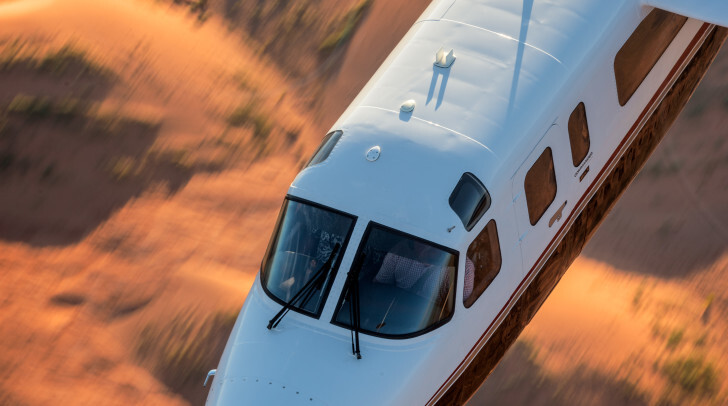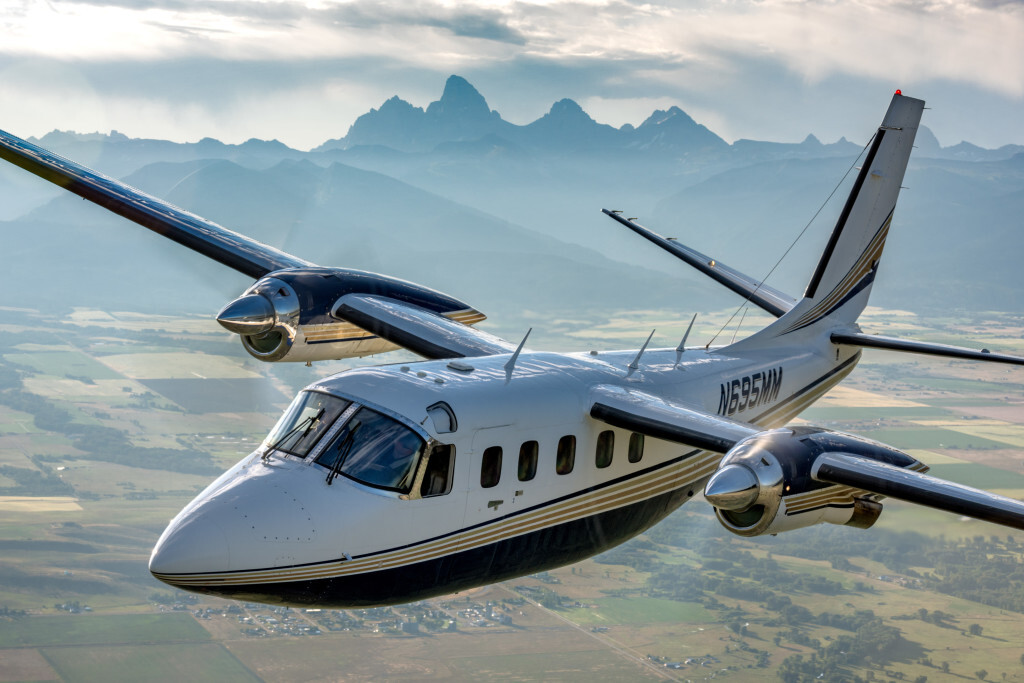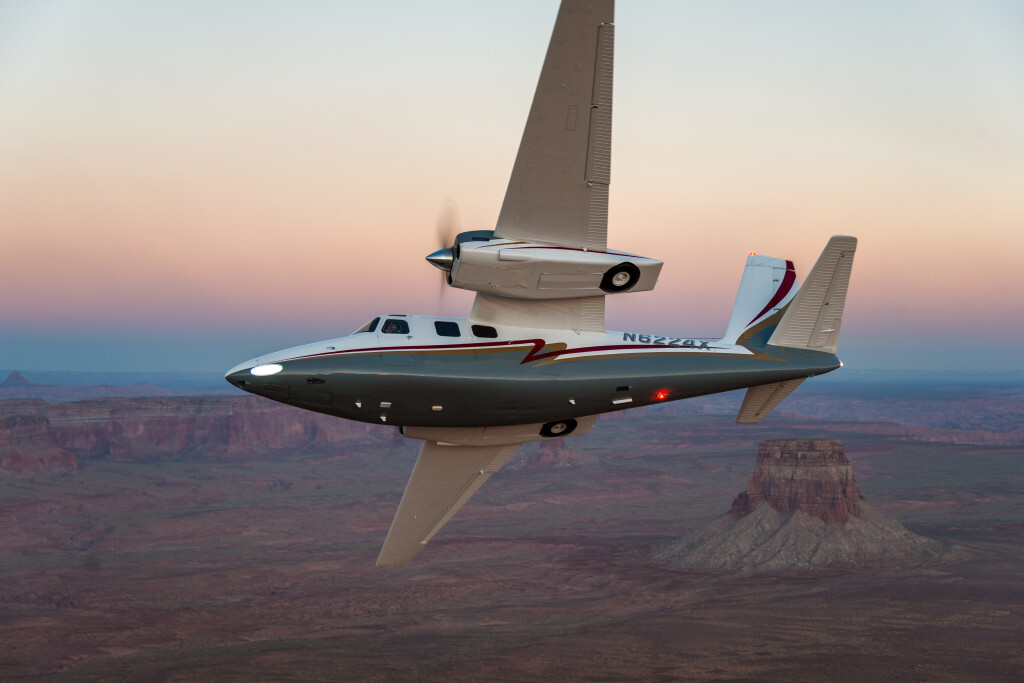By Mark Matheson

Airplanes are conceived, designed, developed, and manufactured to do one thing: Fly. So when it comes to photographing an airplane, it makes sense to capture it doing what it does best. Sounds simple enough, but getting a clear, sharp, colorful, descriptive, beautiful photograph of an airplane doing its thing is anything but simple.
Getting great photos of one Twin Commander isn’t what Mark Matheson set out to do, however. His mission was to photograph three different Commanders. In three different locations. In just three days.
Mark owns Matheson Media, the marketing agency for Twin Commander Aircraft, and he needed to replenish the photo library that he and his staff rely on for Flight Levels magazine, www.twincommander.com, the monthly eNewsletter, and various other Twin Commander Aircraft communication and marketing products. Mark, who is a pilot and aircraft owner, had previous experience with air-to-air photo shoots, so he was fully aware of the complexity involved in organizing and accomplishing one.
“There are so many variables involved,” Mark says. “First, there’s the photographer. Air-to-air photography is a real specialty, and there are very, very few people who are good at it. It’s a dynamic, noisy, turbulent environment—totally different than a controlled shoot in a studio, or taking statics on a ramp. Then you have to have the subject airplane, of course, and a platform—an airplane to shoot from. The platform has to be able to fly at a high enough speed so that the subject airplane won’t have to fly with flaps extended or at a nose-high deck angle. And you have to have pilots flying the subject and platform airplanes who are experienced formation pilots.
“But that’s just the start,” he adds. “You have to have the right locations—mountains, desert, seashores, open water—the specific background you want to see in the photos. Then you have to have the right weather, which means few or no clouds and a rising or setting sun for that beautiful golden light. Finally, when you’ve lined up all of those variables—photographer, subject and platform airplanes, pilots, location, and the weather—you have to pray that no mechanical issues or other problems pop up at the last minute to crush all of that careful, detailed, and expensive planning and preparation.” Mark was facing all of that, times three, for this assignment.
He began the planning last spring. First task: find a photographer. His research led him to Tyson V. Rininger, an experienced aviation photographer with an impressive resume of dramatic general aviation, military, and warbird photos, and a fan of Twin Commanders (http://www.tvrphotography.com). Tyson was all in for the assignment, and he came with a bonus—a recommendation for a formation pilot, Erick Teeters, whom he has worked with on other air-to-air assignments. Mark made the call.

Could Not Say No
“Tyson and I have flown close formation with everything from Navy drones and rocket sailplanes to FiFi, the B-29,” Erick says. “I cut my teeth in a 690B. Recently I’ve been flying King Airs and Conquests and so dearly miss the Commander. When the opportunity arose to get back into the saddle of the Commander, there was no way I could say no.”
Next up, a platform airplane and pilot. A Beechcraft 58 Baron is the ideal platform because of its 165-knot formation speed, and the ability to remove the rear cabin doors to provide the photographer with a nearly unobstructed view of the subject airplane. Mark sought help through BeechTalk.com, operated by the Beechcraft Owners and Pilots Group, and got a hit. Matt Mullahy, who owns and flies a Baron 58 out of Iowa and has formation photo experience, including approval to fly formation with the military, was agreeable to participate in the Twin Commander shoot. Mark had his team.
Next on the checklist was the object of the entire exercise—the Commanders to photograph. Mark turned to the Twin Commander authorized Service Center network for help identifying candidates, and thanks to recommendations from Rob Louviaux at Executive Aircraft Maintenance, came up with three: a Commander 500B owned by John Levitz and flown by Brian Ryckman; a Model 840 owned and flown by Rick Butler; and a Model 1000 owned by Howard Elmore, Mark Hillgren, Gus Osterkamp, and John Elmore and flown by John Kelly.
All three aircraft are based in the western U.S., and several of the owners had homes in scenic areas out west, so that drove the choice of locations—Idaho Falls just west of Grand Teton National Park, Monument Valley in northeastern Arizona, and the Lake Powell area in southeastern Utah.
And, amazingly, everyone’s schedule meshed at the end of July following AirVenture, where Tyson had been shooting for EAA. “Ultimately, it all came together,” Mark says.
Tyson and Erick airlined to Boise on a Sunday, Mark flew his Piper Turbo Aztec from Seattle to Boise, and then the three of them flew in the Turbo Aztec to Idaho Falls, where John Kelly was waiting with the 1000. Matt arrived that evening in the Baron after circumventing severe weather over the Rockies.
They briefed the photo flight that evening over dinner, and agreed on a 4:30 a.m. show the next morning for a 5:30 a.m. launch. The first unexpected problem popped up early the next morning when Matt could not remove a screw securing the rear cabin door hinge to the Baron’s airframe. With launch time approaching and the photo shoot in doubt, the team made a run to a nearby 24-hour Walmart to buy a Dremel tool, which succeeded in removing the screw. They took off just 15 minutes behind schedule.
Over the next two-to-three hours the two aircraft flew around far eastern Idaho and western Wyoming, circling one of the Commander owner’s farms, and then the mountains, including Grand Teton, that divide the two states. Mark said that at around 10,000 feet the air was turbulent and chilly, but the scenery and the light made up for the discomfort.
The first shoot set the pattern for the two that would follow: Matt flying the Baron in the lead with Tyson in the aft cabin facing rearward to shoot the subject airplane; Mark also in the Baron to provide another set of see-and-avoid eyes; Erick in the left seat of the subject airplane with John in the right.
Up, Down, Forward, and Back
Generally, the platform and subject airplanes were some 30 yards apart. Wearing a headset and using an agreed-upon frequency, Tyson would give Erick brief, specific instructions on how many feet to move up, down, forward or back to position the subject airplane. For a more head-on shot of the Commander, Tyson would have Matt slip the Baron nose right while Erick slipped the Commander nose left.
Erick put the Commander in various configurations: flaps down, flaps and gear down, clean. Turns were discussed, then initiated after a count-down to make sure the two airplanes banked in unison. The work was exhausting, especially for Erick, and every 30 minutes or so he would break formation, take a breather, then join back up.
Even though he had been involved in photo shoots before, Mark was impressed. “I’m just amazed at how well the platform and subject airplanes flew together so well,” he says. “These were experienced formation guys.”
“The Commander is a pilot’s airplane,” Teeters says. “Even in close formation with a dissimilar aircraft it can be put precisely where I want it with ease: 10 feet up, 5 down, 20 forward. If I wanted to I could tickle the static wicks on the Baron with the Commander.”
Back at Idaho Falls they quickly reviewed the shots and declared the mission a success. Incoming weather kept them on the ground until mid-afternoon, when they took off in the Aztec and Baron for Page, Arizona, where the 840 was positioned. The 500B soon arrived from the Scottsdale area.
They had planned to fly early the next morning to photograph the 500B, but conditions were looking ideal so they decided to have an early dinner, come back to the airport, and do the shoot that evening over Lake Powell. It came off without a hitch, with the camera showing excellent results.
When they got to the airport at 4:30 a.m. the next morning Rick Butler was in his 840 Commander, beacon flashing, “ready to go,” Mark says. They removed the cabin door on the Baron, got Tyson strapped in, and took off. The next couple of hours were spent doing formation 360-degree turns over Lake Powell, and then southeast to Monument Valley for more 360s. Finally, with the sun rising higher and the light growing harsher, the shoot was declared over.
“It’s now 7:30-8:00 a.m. Tuesday morning, and we were done,” Mark says. Three months of meticulous planning had brought together five airplanes, five pilots, an observer, and a photographer, all of whom spent three intense days flying and photographing. Three days when “nothing broke, the weather was good everywhere, and it all worked.”

100 Percent Focused
“I think the most challenging part of the shoot for me was coming straight from EAA where we work 18-hour days for a week straight,” Tyson says. “Being that the Commander photo shoot was for a client as opposed to volunteering for EAA, there was a lot more pressure to perform and provide outstanding results. After a grueling week, it was a real test to be 100-percent focused.”
The thousands of digital images recorded on Tyson’s cameras eventually were culled to a treasure trove of fewer than 100 “keepers”—typical for an air-to-air shoot. “The gear used to create these images, including the lens, camera and gyro, weighed about eight pounds,” Tyson explains. “In itself, no big deal, but after two-to-three hours it can get pretty heavy. And, even with the gyro, the camera needs to be held perfectly still in order to use a low shutter speed for prop blur while maintaining crisp focus.”
“Mark did an amazing job putting this team together,” Says Erick. “To have a group of men assemble from all parts of the country and coordinate so well together was amazing, and all to his credit. It was a great team, and we were able to highlight an amazing aircraft. Amidst mountain waves over the Tetons and tense moments a few hundred feet off the deck over Monument Valley, we were able to have our artist Tyson bring out the true artistry of the Commanders design. It was one solid group of aviators, and it’s amazing to me that in a moment’s notice our love for aviation brought us together as a team, as if we had never been apart.”
“I’m so grateful to have had an experienced camera ship pilot,” Tyson says. “Matt was rock solid the whole time and showed excellent judgment. It’s no wonder the air force trusts him to fly alongside F16s in his Baron. Also, I’m grateful to all the owners and pilots I was able to fly with, and on such short notice become a team with them in the cockpit to make the magic happen. Thanks to Mark for putting the whole thing together.”
It’s extremely rare for so many variables to line up and behave, but that’s what happened with the three-in-three Twin Commander photo shoot. Of course, all the planning would have been for naught if it hadn’t been for the enthusiastic participation of the Commander owners.
“We owe them a great debt of gratitude,” Mark says. “They donated their airplanes and, in the case of the 500B and the 1000, their pilots. That’s huge.” Their generosity isn’t without its rewards, however. The owners will be enjoying great photographs of their airplanes for a long time to come.
